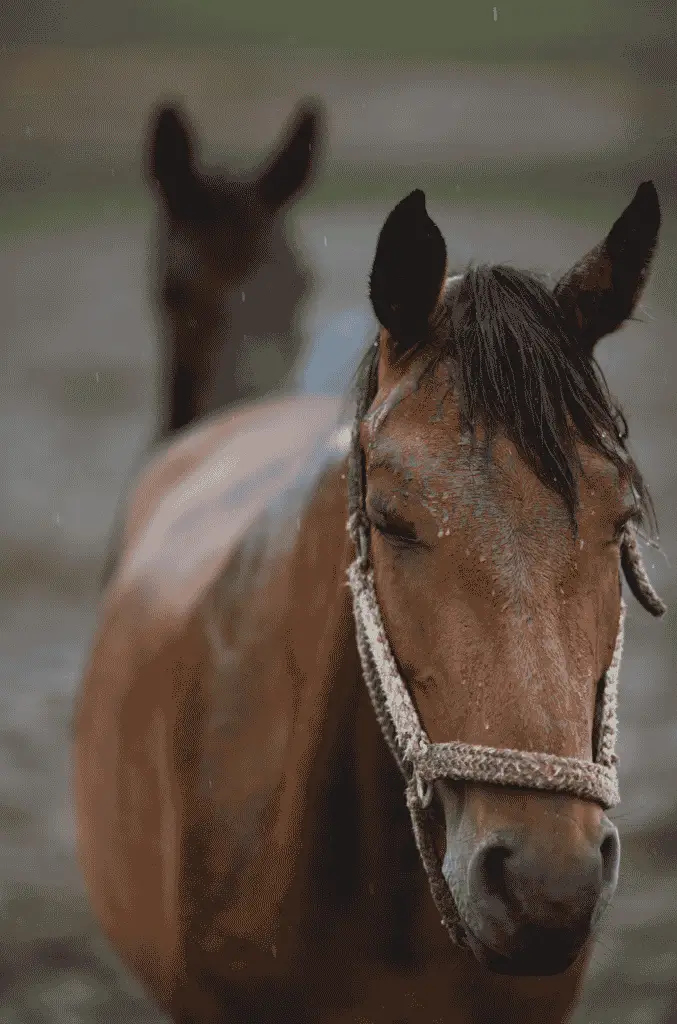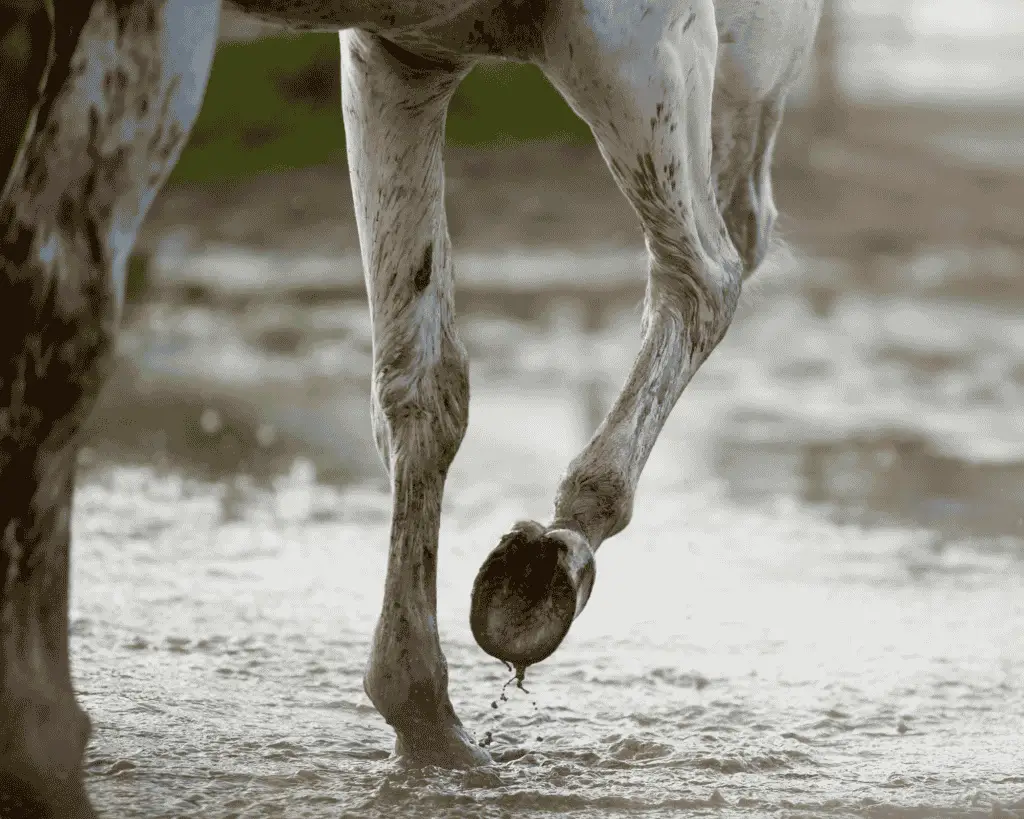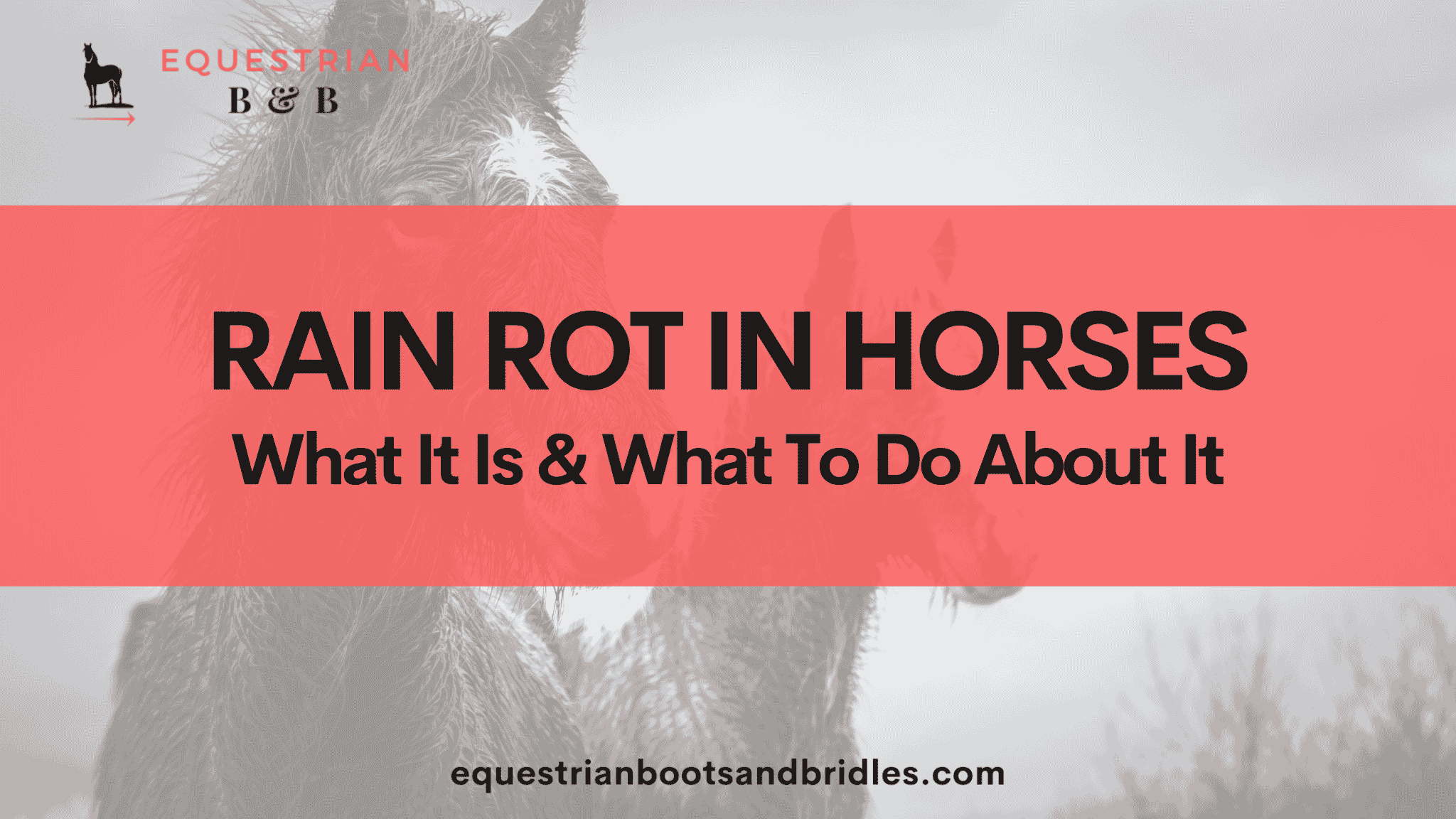Rain rot, also known as rain scald, is a type of skin infection that occurs during periods of wet weather. It’s caused by a bacteria that lives on the skin of horses, but usually lies dormant until activated by wet conditions. The condition appears primarily on a horse’s rump but can also become apparent on other parts of the horse’s body. Rain rot in horses is one of the less irritating skin conditions, but it’s unsightly due to scabbing and hair loss and makes the horse’s skin tender. Fortunately, it’s an easy condition to prevent and when it does happen, treatment is straightforward.
Some coat colors are more prone to rain rot, and horses that have a compromised immune system are at higher risk of developing the condition. Horses with rain rot won’t feel itchy, but the affected area can be painful and sensitive, causing a horse to pull away from your touch.
You’ll notice the beginning stages of rain rot a few hours after a horse has come in from the rain. The hair near a drip line of water stands up and feels warm to the touch, and your horse might flinch away from you. The next day, you’ll likely see scabs forming in the area where the hair standing up in a strange pattern, and your horse wants nothing to do with you touching them. This is the classic appearance of rain rot and begins your efforts to resolve the condition so your horse is comfortable again.
What is Rain Rot?
Rain rot gets its name from the fact that it develops when a horse spends a lot of time standing out in the rain. It’s caused by a bacteria known as Dermatophils congolensis that lives in the coat of all horses and stays dormant until weather conditions are right for it to multiply and invade an open sore. A horse that’s always wet and doesn’t have an opportunity to dry out is vulnerable to rain rot due to the loss of protective skin oils.
When rain rot bacteria respond to the right conditions, they irritate the hair follicles and skin of a horse. It takes very little time for the rain rot to take hold and make your horse uncomfortable. It’s worth noting that the bacteria can’t get past the skin layer on a healthy horse, and the formation of rain rot requires a horse to have an insect bite or other open sore on its body.
Horses frequently have some type of open sore due to bug bites, scrapes from contact with objects, a kick from another horse, and so on. It’s difficult to keep a horse’s skin free from damage, which makes it easier for them to contract rain rot.
The bacteria invade the open wound and cause an immune response that delivers proteins and white blood cells to the location. These cells accumulate and create a pus-filled bump on the skin known as a pustule. The skin layer underneath the pustule dies off, causing the dead skin cells to clump together with hair follicles. This results in the appearance of hair standing up on end in a tuft known as a paintbrush lesion.
A horse may experience itchy or sensitive skin while its immune system does its duty, and scratches itself to find relief. This can cause further scrapes on the skin, opening itself up to more bacterial infection and spreading the rain rot.
The skin irritation caused by the pustules results in the formation of scabs in a variety of patterns. You may see anything from a small cluster of scabs on a horse’s topside to large areas covered in scabs.
Ringworm and rain rot have similar appearances in that they both cause circular patches of skin from hair loss. However, both skin conditions have different causes, and you can determine a case of rain rot based on the weather and your horse’s recent activities. You can read more about ringworm in horses here.

Why Rain Rot Happens
Rain and humidity are the perfect weather conditions to encourage the rain rot bacteria to multiply. All it takes is a combination of rainy weather with humid conditions afterward to stimulate the bacteria to grow and attack an open sore.
Another cause of rain rot is when a blanket or sheet without breathability is used on a wet horse. Nylon or polyester sheets that don’t allow air to flow through serve to trap the moisture in a horse’s coat. Add into that the fact that these materials also trap heat, and you get the perfect conditions for rain rot to form.
How to Prevent Rain Rot in Horses
Good management is the best way to prevent rain rot from taking hold. Paying attention to the forecast for periods of rain is the first step in preventing rain rot. The forecast will inform you about what you’re doing with your horse that day in terms of turning them outside or keeping them in. Minimizing exposure to wet conditions is the easiest step to take when figuring out how to prevent rain rot in horses.
If your horse is one that doesn’t like to stay indoors for extended periods of time, or just needs to stretch its legs, cover it with a rain sheet for protection. The less moisture that can reach the coat, the less likely your horse is to develop rain rot.
Sometimes it happens that a horse won’t keep a sheet on no matter what you try, making it more difficult to prevent rain rot. Turning them out in an indoor setting is optimal, but not always available. When indoor turnout isn’t available, the best solution is to offer them shelter of some kind and give them the option to go inside.
Treating Rain Rot
Once it’s apparent your horse has rain rot, you need to get on top of it as soon as possible. The rain rot treatment depends on the severity of the infection. A minor case can be resolved with a little extra care in the form of baths with an antibacterial soap and regular grooming with curry and brush. More severe cases require the use of antibiotics from a veterinarian.
You can clip hair away from the affected area before you begin treatment. This will allow the treatment to easily reach the area of rain rot development and work more effectively.
The most common rain rot treatment process consists of clearing the area of debris, removing scabs to allow drainage, and washing the area with an antibacterial product. You can use a shampoo that contains chlorhexidine, benzyl peroxide, or povidone-iodine, or a remedy of your choice. Dry the treated area after the treatment has been in place for the recommended period of time.
There are a number of products on the market for treating rain rot in horses, and you’ll find that horse owners have a product they swear by. What you use is a matter of finding a product that works best for you and your horse.

Rain Rot in Horses Home Remedies
The goal of treating rain rot in horses is to kill off the bacteria that cause the condition to appear. There are plenty of products on the market that have antibacterial properties that aren’t necessarily intended for use on rain rot, but still work well for this purpose. Horse owners frequently turn to treating rain rot in horses with home remedies due to the ease of access, lower cost, and effectiveness.
Home remedies are usually just as effective as medicinal remedies for rain rot. They may require a little more elbow grease when it comes to application, or they’ll take a little longer to work, but they will alleviate and resolve a case of rain rot.
Apple Cider Vinegar
Apple cider vinegar (ACV) is a popular home remedy for rain rot. A simple search of the internet for ‘apple cider vinegar rain rot horses’ returns multiple hits in the form of horse owners discussing how they’ve had success with using ACV on rain rot. The reason why ACV works is that it has antibacterial properties and is concentrated.
Treatment with ACV consists of pouring it onto a wet sponge and applying it directly to the afflicted area. Another method is to pour it directly onto the area and work in with a brush, but don’t share the brush. Apply the ACV until the rain rot resolves.
You may want to dilute the ACV with water prior to application, especially if your horse has sensitive skin. Full-strength ACV can cause a burning sensation that your horse may not appreciate.
Dish Soap
Dish soap is safe for use on horses and is known to be effective against rain rot. It has antimicrobial properties that kill off bacteria in the skin and stops the rain rot. It’s also gentle on the skin and hair, and won’t dry out the skin.
Mouth Wash and Baby Oil
Combine equal parts of mouth wash and baby oil together into a spray bottle and apply it to the area affected by rain rot. You can apply mouth wash without the baby oil, but it may be too harsh for your horse’s skin and haircoat.
Tea Tree Oil
Tea tree oil is famous for its antibacterial and pain-relieving properties and can be left on the skin after treatment. It keeps the skin dry and acts as a protective barrier while continuing to control the bacteria.
Coconut Oil
Coconut oil is recommended for removing scabs as it softens them up without the need to use water. Simply apply the coconut oil directly to the scab and rub it in. You’ll see the scab lift away from the skin, enabling you to pick or brush them off without discomfort for the horse. Coconut oil has another benefit in that it adds a layer of waterproofing to the skin and keeps moisture out of an infection for longer.
When to Try a Home Remedy vs. Getting the Help of a Vet
The time to try a home remedy is when the first signs of rain rot appear on your horse. Rain rot doesn’t necessarily need a diagnosis from a vet as it’s something that’s a common occurrence in horses, especially in regions where long periods of rain are expected. Most horse owners go into the equine medicine cabinet and pull out their favorite home remedy for rain rot when it appears.
Rain rot is relatively easy to resolve with home remedies or with rain rot remedy products bought at the farm store. However, there are situations where you’ll have to call the vet for help with a case of rain rot.
There are times when rain rot causes secondary infections or the condition isn’t rain rot at all, but rather another type of bacterial or fungal infection. One of the reasons why you’ll need a vet call is that the scabs from rain rot can fall off and leave an open sore that gets infected. Another reason is the rain rot is actually ringworm, which looks like rain rot.
If your horse is experiencing a resistant case of rain rot, give the vet a call. Your vet can perform a biopsy of the affected area and determine the cause, then prescribe the appropriate medication and treatment.
FAQs About Rain Rot
Can rain rot be prevented?
Yes, rain rot prevention is preventable by keeping your horse dry and covered during rainy periods. If your horse is prone to contracting rain rot, you need to keep them indoors or covered with a rain sheet during periods of turnout.
Is rain rot contagious to other horses?
The good news about equine rain rot is the fact that it’s not contagious. A horse that develops a case of rain scald won’t transmit it to another horse. Horses with compromised immune systems are more likely to develop rain rot, so if you have two horses who have contracted rain rot, you may have two horses that have developed rain rot for entirely different reasons.
Can I treat rain rot with an antifungal?
No, rain rot can’t be treated with an antifungal agent. It’s caused by bacteria and requires the use of antibacterial agents for treatment.

